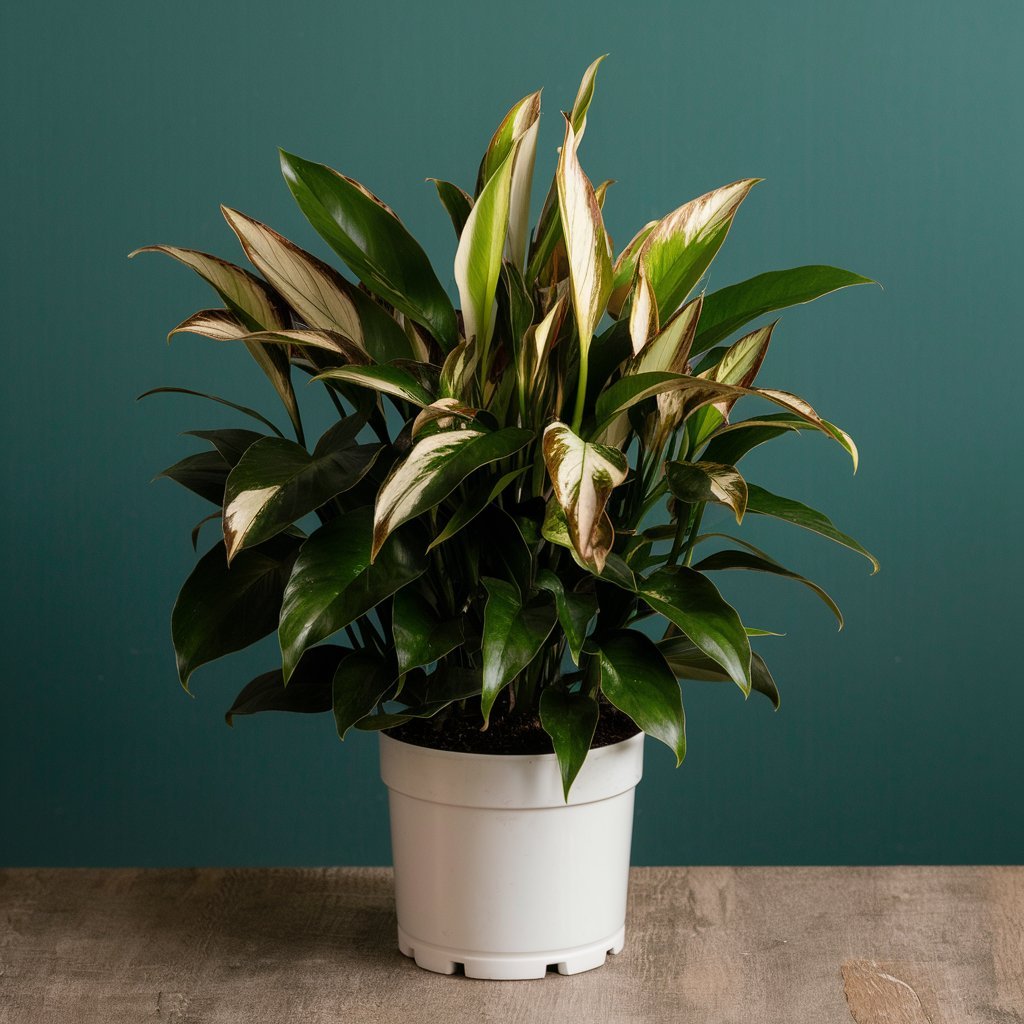Peace lilies are one of those plants that seem to bring a touch of elegance to any indoor space. Their deep green leaves and striking white flowers make them a popular choice for many plant lovers. But if you’ve ever owned a peace lily, you might have noticed sometimes Peace lily brown tips happens.
It’s a common problem, and it’s frustrating to see your once-perfect plant start showing signs of distress. But don’t worry! Brown leaf tips are usually a signal that something in your peace lily’s environment isn’t quite right. The good news is, with a little detective work and some simple adjustments, you can get your peace lily back to looking its best.
In this blog, we’ll dive into the most common reasons why peace lilies develop brown leaf tips and, more importantly, how you can fix the issue and prevent it from happening again. So, let’s get started on bringing your peace lily back to its full, lush glory!
Reasons and solution of Peace lily brown tips
Table of Contents
Common Causes of Peace lily brown tips
If you’re seeing brown tips on your peace lily, it’s your plant’s way of telling you something’s off. Let’s walk through the most common culprits behind those unsightly brown edges and how you can identify them.
Overwatering
Peace lilies like their soil to be moist, but there’s a fine line between moist and soggy. Overwatering is one of the top reasons for brown leaf tips. When the roots are constantly wet, they can’t get enough oxygen, leading to stress and those tell-tale brown tips. If you notice your peace lily’s leaves are yellowing before they brown, overwatering could be the issue.
Underwatering
On the flip side, peace lilies don’t like being thirsty either. If you forget to water your plant for too long, the leaves will start to dry out, causing the edges to turn brown and crispy. If the soil feels dry to the touch, and the plant seems to droop, it’s time to give it a good drink.
Low Humidity
Peace lilies are tropical plants, which means they love humidity. If the air in your home is too dry, especially in the winter when the heat is on, the lack of moisture can cause the leaf tips to brown. Peace lilies thrive best in humid environments, so if you live in a dry area, you might need to take some extra steps to keep your plant happy.
Direct Sunlight Exposure
While peace lilies are pretty easygoing when it comes to light, they don’t appreciate being in direct sunlight. Too much sun can scorch the leaves, leading to brown tips or even full-on browning of the leaves. If your peace lily is sitting in a sunbeam for most of the day, it’s likely getting more light than it can handle.
Salt Buildup in Soil
Over time, minerals from fertilizers and even your tap water can build up in the soil, leading to salt accumulation. This salt buildup can draw moisture away from the plant’s roots, causing stress and—you guessed it—brown leaf tips. If you’re regularly fertilizing your peace lily, this might be something to look into.
Temperature Extremes
Peace lilies prefer a stable, moderate temperature. If they’re exposed to cold drafts from a window or door, or if they’re near a heating vent blasting hot air, the leaves might start to show brown tips. Temperature fluctuations can stress your peace lily, leading to those annoying brown edges.
Chemical Sensitivity
If you’re using tap water for your peace lily, it could be reacting to chemicals like fluoride or chlorine. These chemicals can be harsh on sensitive plants, causing brown tips to appear over time. Switching to filtered or distilled water can help prevent this.
By figuring out which of these issues might be affecting your peace lily, you’ll be well on your way to restoring it to health. In the next section, we’ll cover exactly how to fix these problems and keep your peace lily looking its best.

How to Fix Peace lily brown tips
Now that we’ve identified the possible reasons behind those brown tips, let’s talk about how to fix them. The good news is that with a few adjustments, your peace lily can bounce back to its vibrant, healthy self. Here’s what you can do:
Adjusting Watering Practices
Maintaining the happiness of your peace lily requires proper hydration. Let the soil dry out a little before watering it again if you think you may have been overwatering. It’s time to water if you can insert your finger about an inch into the soil and it feels dry. Peace lilies detest sitting in soggy soil, so make sure the pot has adequate drainage so any extra water can be released. Conversely, if your plant is submerged, you may need to water it more frequently, particularly during the warmer months.
Increasing Humidity
Since peace lilies love humidity, adding some moisture to the air can work wonders. You can mist the leaves regularly, place the plant on a tray of pebbles filled with water, or even get a small humidifier for the room. This extra humidity will help prevent those tips from drying out and turning brown.
Correcting Light Conditions
If your peace lily is getting too much direct sunlight, it’s time for a move. Find a spot with bright, indirect light—like near a north or east-facing window. Your plant will still get plenty of light but without the risk of sunburn. If moving it isn’t an option, you can diffuse the light with a sheer curtain.
Flushing the Soil
To deal with salt buildup, a simple fix is to flush the soil. Every few months, take your peace lily to the sink and slowly pour water through the soil until it runs out of the drainage holes. This helps wash away any accumulated salts. Just make sure the water you use is free of chemicals that could harm the plant, like fluoride or chlorine.
Temperature Management
Peace lilies prefer consistency when it comes to temperature. Keep them away from drafty windows, doors, or heating vents to avoid stress from sudden temperature changes. Aim to keep the room temperature between 65-80°F (18-27°C), and your peace lily will thank you by staying lush and green.
Using the Right Water
If your tap water contains chemicals like fluoride or chlorine, switching to filtered or distilled water can make a big difference. These chemicals can be harsh on your peace lily, leading to those dreaded brown tips. Rainwater is also a great, natural option if it’s available to you.
By following these steps, you can address the root causes of brown leaf tips and help your peace lily thrive. Consistent care and attention will keep your plant looking beautiful and healthy for years to come. In the next section, we’ll discuss some preventive measures to ensure your peace lily stays in top shape.
Preventive Measures to Keep Peace Lilies Healthy
Once you’ve nursed your peace lily back to health, the next step is to keep it that way! Prevention is always better than cure, so let’s look at some simple habits that will help maintain your peace lily’s beauty and keep those brown tips at bay.
Regular Monitoring
Catching issues early is one of the best ways to avoid them. Establish a weekly routine of examining your peace lily. Keep an eye out for any indications of stress, such as brown tips beginning to appear, drooping, or yellowing leaves. You can modify your daily care regimen before things worsen by recognizing these early warning indicators.
Proper Fertilization
Feeding your peace lily the right way can make a big difference. Use a balanced, water-soluble fertilizer, but remember—less is more. Over-fertilizing can lead to salt buildup in the soil, which we know can cause brown tips. Feeding your plant every 6-8 weeks during the growing season should be enough to keep it nourished without overdoing it.
Routine Maintenance
A little routine maintenance goes a long way. Trim off any damaged or brown leaves to keep your peace lily looking neat. Regularly dusting the leaves with a damp cloth not only helps the plant look its best but also improves its ability to absorb light and breathe. And don’t forget to rotate your plant every few weeks so it grows evenly and doesn’t start leaning toward the light.
By incorporating these preventive measures into your care routine, you’ll ensure that your peace lily remains a lush, vibrant centerpiece in your home. A little extra attention now can save you a lot of trouble down the road, keeping those brown tips at bay for good.
In the next and final section, we’ll wrap things up with a quick recap and some final thoughts on how to keep your peace lily thriving!
Should a Peace lily’s Brown Leaves Be Removed?
If you’re noticing brown leaves on your peace lily, you might be wondering whether you should just leave them alone or snip them off. The answer is pretty straightforward: yes, you should remove the brown leaves, and here’s why.
First, brown leaves aren’t going to turn green again. Once a leaf has browned, it’s essentially dead tissue that the plant no longer needs. Leaving these damaged leaves on your peace lily doesn’t do any good. In fact, they can actually take away from the overall look of your plant and might even drain some energy from the healthier parts of the plant.
Trimming off those brown leaves isn’t just about aesthetics—it’s also about encouraging new, healthy growth. When you remove the dead or damaged leaves, the plant can redirect its energy toward producing new leaves and maintaining the health of the existing ones. Plus, keeping your plant neat and tidy can help prevent any potential pests or diseases from taking hold in the dead foliage.
Here’s a simple way to do it: use a clean, sharp pair of scissors or pruning shears, and cut the brown leaves off at the base of the stem. If only the tips are brown and the rest of the leaf looks healthy, you can just trim off the brown parts, following the natural shape of the leaf. This way, your plant stays looking fresh and vibrant.
So, go ahead and give your peace lily a little trim when you see those brown leaves. It’s an easy step that will keep your plant looking its best and ensure it stays healthy and happy!
Conclusion
Caring for a peace lily is all about balance—finding that sweet spot where your plant feels just right. Brown leaf tips can be a bit of a headache, but they’re also a helpful sign that something needs adjusting in your plant’s environment. By understanding the common causes like overwatering, low humidity, or too much sunlight, and taking steps to correct them, you can bring your peace lily back to its lush, green self.
Remember, regular care and a watchful eye are key. With the right watering habits, proper light, and a little extra humidity, your peace lily will thrive. And don’t forget the simple preventive measures—routine checks, gentle fertilizing, and a bit of maintenance go a long way in keeping your plant healthy and happy.
So, here’s to seeing your peace lily flourish! With these tips in hand, you’re well on your way to enjoying a beautiful, thriving plant for years to come. Happy gardening!





Pingback: Why Your Peace Lily Isn't Flowering and How to Fix It - Garden Gossips
Pingback: Are Peace Lilies Toxic to Cats? Essential Safety Tips for Cat Owners - Garden Gossips